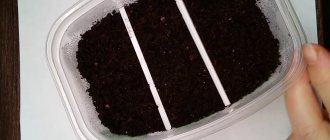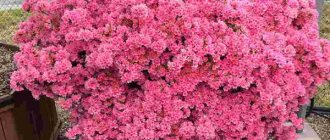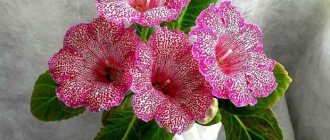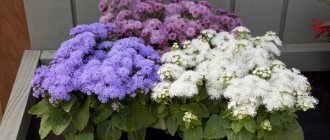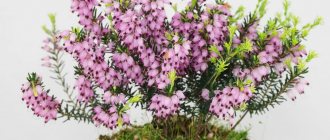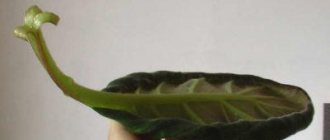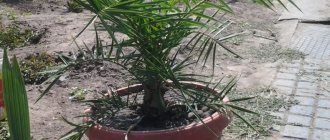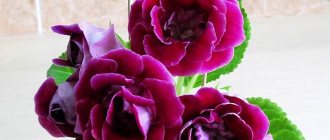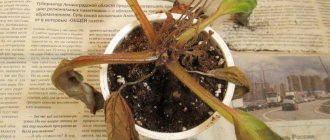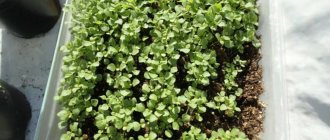Features of wintering
Attention : Winter for adult indoor gloxinia is a period of rest. A plant that has bloomed at least once and managed to grow tubers enters a state of dormancy. The larger the tuber, the better it is stored. A young specimen of the first year of life may not fall asleep for the winter.
When to retire? This should not be done forcibly. This gloxinia has a small tuber less than two centimeters in diameter, which can dry out and die in winter conditions without watering. A young plant needs special care during the winter season:
- Ensures correct temperature conditions . Indicators should not rise above +20°C. If the room is too hot, the stem will stretch to the detriment of tuber growth.
- Water less often than in the summer season (read about how to properly water and feed gloxinia for long flowering here). Otherwise, waterlogging will lead to rotting of the roots.
- Organize lighting . Daylight should last at least 12 hours a day. In the absence of additional lighting, the flower becomes very elongated. To prevent this, the room temperature is reduced to +18°C. Or, at the end of February, the long stem is cut off, leaving only the lower leaves.
Read in detail about what needs to be done next after the gloxinia has bloomed, and from this article you will learn about the features of flower care at home.
How to wake up a plant
If the flower tubers are healthy, they will wake up on their own . But if for some reason this does not happen and the flower continues to rest, then you can wake up the sleeping plant as follows:
- Prepare a plastic bag.
- Place two tablespoons of soil based on peat at the bottom of the bag.
- Moisten the soil a little with cold water.
- Remove the tuber, rinse it well with cold running water and carefully check for rot. If everything is fine, then it needs to be dried and placed in a plastic bag.
- Tie the bag well and place it in a place where it is light and warm, perhaps under a lamp.
After two weeks, condensation will begin to appear on the walls inside the bag, and green sprouts will begin to appear from the plant tuber. The gloxinia root has already woken up and needs to be planted in a flower pot.
The brighter the light that falls on the gloxinia bulb, the more new and young shoots are formed on it.
To awaken a flower, moisten the tuber with water, place it in a bag and place it under a lamp
Rest period
When should gloxinia be removed for the winter, for rest? Typically, the plant goes into a midnight state in September-October, which marks the start of the dry season in their homeland of South America.
In the case when the plant has faded and does not want to fall asleep, it needs help. If gloxinia does not go on vacation on time, the flowering dates will shift, which should fall in the spring and summer months.
To prevent this from happening, at the beginning of autumn, faded gloxinia begins to be prepared for wintering. If flowering is late, wait until it ends. After complete independent death of the above-ground part, the tuber is ready for storage. If everything is done correctly, gloxinia will begin to wake up no earlier than January - February .
Average universal parameters
- A place without bright lighting.
- Temperature range from +3 to +15 degrees.
- Humidity no more than 90% and no less than 60%.
As a result
We simulate weather factors that are familiar to a plant in its natural habitat.
Proposed storage locations for tubers
Refrigerator , the department with the lowest temperature, where vegetables and herbs are usually stored. There is a danger of drying out the tubers, so you need to regularly check the substrate for moisture.- Insulated balcony or loggia , where the temperature does not rise above twenty degrees, since the plant can wake up from the heat.
- The cellar is deep and warm, where the temperature drop does not go beyond +3-5 degrees. Storage in the cellar is possible only with moderate humidity, when the walls and shelves are not affected by mold. Here you can safely leave the tubers and not worry that they may dry out.
- Under the bathroom. Humidity and light parameters are ideal, but the temperature may not correspond and may be higher than expected.
- On the mezzanine in the hallway. The main thing here is not to forget about hydration.
Detailed description
To maintain the viability of adult tubers, gloxinia must be properly prepared for winter rest:
- In September-October, after flowering, place gloxinia in a less lit place, for example, on a northern windowsill. Provide temperature +15°C. Feed once with potassium fertilizer. Gradually reduce watering. Moisten the soil with small portions of water no more than once a week.
- When the leaves begin to dry, stop moistening the substrate. You cannot immediately cut off the above-ground part of the plant. You need to allow the nutrients to gradually move into the tuber from the stem and leaves. If you cut off green foliage, vegetation processes may resume.
- After the upper part has completely died off on its own, cut it off, leaving a small stump one to one and a half centimeters high.
When to retire gloxinia. How to prepare gloxinia for the dormant period
Watering should be very moderate.
If Sinningia is young, it cannot be hibernated. It is necessary to provide twelve-hour lighting, temperature - +20. Water occasionally.
in spring
To wake up from winter rest, the flower can be covered with cellophane.
Before planting, you need to check the tuber for damage. If detected, they should be eliminated, the wounds should be treated with brilliant green and ash.
In spring you need to inspect gloxinia tubers
For better disinfection, tubers are treated with a solution of potassium permanganate. The potato is cut into two parts to check its condition.
If the cut is yellowish or pinkish, it is treated with crushed activated carbon. Each part is planted in separate containers for further cultivation.
A brown or black cut indicates the death of the plant.
In the spring they begin to fertilize. To increase green mass, nitrogen is added first. The next step is complex fertilizers with a low proportion of nitrogen.
Storage methods and conditions
When the preparation is completed, you need to send the tuber for the winter. Storage methods:
- Leave the tuber in the pot . You can sprinkle it with river sand. Cover the flowerpot with a saucer, place in polyethylene and place in a cool place with a temperature of +10 to +15°C. Make sure that the tuber does not dry out completely. Lightly moisten the soil by spraying several times during the winter.
- Two weeks after the aerial part has completely died off, dig up the tuber . Clear away any remaining roots. You can wash it in water, dry it and treat it with Fitosporin. Take a plastic bag with a zipper and pour slightly damp sawdust or river sand or crushed peat into it. Or take a mixture of substrate and vermiculite. Rinse the sand first and place it in a hot oven.
- Place the tuber in a bag . Store in a box in a cool place at a temperature of +10 to +15°C. The middle or bottom shelf of the refrigerator door will do. Remove and inspect the tuber monthly. If the substrate is dry, spray it with warm water and return the tuber to its place. Avoid excess moisture.
If the grower has several gloxinias, make labels indicating the variety and the date of sending for wintering.
Important : If the tuber is purchased in the fall, it is disinfected with a special agent and stored without substrate.
As a result of violation of storage conditions, tubers may wake up ahead of schedule , without resting for even two months. In this scenario, it is recommended to choose one of the following options:
If the sprouts that appear are tiny, you don’t have to remove them. Reduce the amount of moisture received.- Cut off young shoots. Return the tuber to its resting place. In the spring, plant it in a pot with new soil (read about how to properly prepare soil for indoor gloxinia here, and from this article you will learn how to choose the right pot for gloxinia, as well as the features of planting and watering the plant). Place in a warm and bright place.
- Plant the plant in fresh substrate. Light with fluorescent lamps. In this case, there is a risk of getting a weak, very thin gloxinia. In this case, at the end of February, you should remove the top of the stem, leaving only the lower leaves. Cut tops can be rooted. After some time, gloxinia will give new shoots.
- Keep the awakened plant in cooler conditions at a temperature of +18°C. Provide good natural light. This way you can avoid the active growth of gloxinia.
Awakening of Gloxinia
With the end of winter, young shoots hatch on the tubers. This indicates that the plant is coming out of sleep. Then prepare fresh soil, water it a little and plant the tubers in it. There is no need to deepen them; it is better to leave the top on the surface. Watering begins 7 days after planting. Do not overwater the plant so as not to provoke fungal diseases.
During the initial growing season, weak shoots are removed, leaving only a few of the strongest ones. This is necessary for better tuber formation. How beautifully and magnificently the gloxinia will bloom depends on its strength.
Important!
Broken off shoots are not thrown away; they will become excellent material for growing new flowers. They are buried in fresh soil, lightly watered and covered with plastic bottles with several holes for ventilation.
Useful video
We recommend watching a video about the features of the gloxinia dormant period and preparing it for winter:
We also recommend that you familiarize yourself with our materials about the rules and subtleties of the gloxinia reproduction process:
- seeds;
- leaf;
- cuttings.
Possible difficulties
What are the leaf diseases of Gloxinia and how is it treated?
With proper care, the tropical beauty Gloxinia can live up to 10 years, delighting its owners with colorful blooms. Moreover, the older and more developed the plant, the more flowers it will have. Sometimes their number reaches 50 pieces!
- There are brown spots on the leaves of gloxinia - this indicates that water has come into contact with them, as well as the use of too cold water for irrigation.
- Gloxinia leaves turn yellow - a sign of dry or too humid air, exposure to direct sunlight or excess fertilizer.
- Gloxinia leaves curl - this happens with excessive feeding and when exposed to drafts.
- Elongated, pale leaves are a sign of lack of lighting.
- A gray coating on flowers and leaves indicates that the plant is infected with gray rot.
- The flowers remain hidden under the leaves - this happens when the daylight hours are short or the temperature is too low.
Appearance
A perennial herbaceous stemless or short-stemmed plant with fleshy shoots up to 25 cm high. The leaves are large, up to 20 cm, ovate, dark green, velvety-pubescent.
The flowers are large, velvety, up to 8-12 cm in diameter, corrugated along the edge, shaped like bells, color: from dark purple to pink and white; plain, speckled or with a border around the edge in various color combinations.
With optimal care, from 8 to 30-40 flowers can bloom on one plant at the same time. Duration and flowering period: about 3 months from March to June, depending on maintenance conditions.
When buying an adult gloxinia, pay attention to the buds - choose a specimen with a large number of unopened flowers. With good care, the plant will delight you with flowering for more than two months.
